- Life top
- Daily Life
- Applying for LINE stickers
- Exhibition of Matsumoto-sensei
- Hana - Shiba-Inu
- Elec. handicraft & Akihabara
- Supermarkets in the area
- Takaido Civic Center
- Building a house
- Horrible dentists
- Judo therapy
- In an elderly care home
- Parties
- Cosplay bonenkai 2010
- Gainax cosplay bonenkai
- Friends from Gainax
- Friends from schooldays
- Party at Bar Espion
- Home party with cheese
- Music Life
- TARO Quartet
- Maeda-san - violin maker
- Chigusa Kindergarten
- Seniors playing music
- My viola debut
- Torakyo regular concert
- Toranomon Orchestra
- Four seasons
- Shrine visit of the New Year
- New Year´s postcard
- Snowfall in Tokyo
- Hina-matsuri and hina-dolls
- Sakura - cherry-blossom
- Sakura - what I missed most
- Fireworks Festival
- People
- Itakura - his adventurous life
- Naoto - his country life
Toranomon Symphony Orchestra
(*) See also the related articles in "Japan as it is" and Torakyo 83rd regular concert
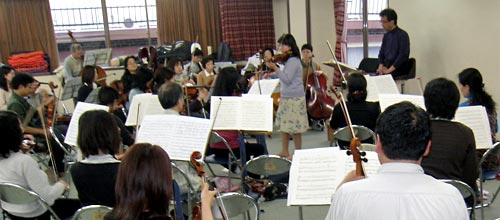
A rehearsal scene at the training camp in Iwai, Chiba prefecture.
I would like to show a few more photos from our recent training camp.
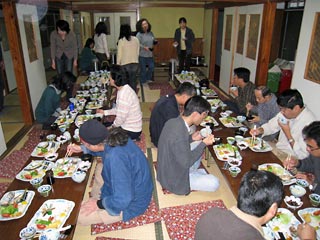
Of course, we sit on tatami mats and take a typical Japanese-style breakfast.
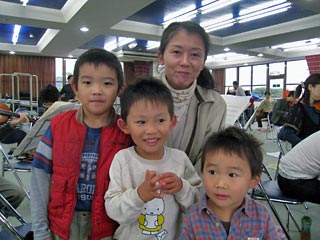
These are all our second generation kids. Mama stops playing now to take care of her two boys (right), while papa continues to play with Torakyo.
I am a member of "Toranomon Symphony Orchestra". It is "Toranomon Kokyo Gakudan" in Japanese and
 we usually call it by the abbreviation "Torakyo". Torakyo was established in 1971 and is one of the numerous amateur orchestras existing in Tokyo. You may be surprised to hear that there are now at least 200, or probably 300, full-scale amateur symphony orchestras in Tokyo. I mean the orchestras whose members are business people, housewives and other adults.
we usually call it by the abbreviation "Torakyo". Torakyo was established in 1971 and is one of the numerous amateur orchestras existing in Tokyo. You may be surprised to hear that there are now at least 200, or probably 300, full-scale amateur symphony orchestras in Tokyo. I mean the orchestras whose members are business people, housewives and other adults.This means that there are at least 10,000 amateur music lovers enjoying European classical music not as mere listeners but as players. They play not only classical works such as symphonies by Beethoven, but also some modern pieces such as Le Sacre du Printemps and Classical Symphony.
There are several reasons why there are so many amateur instrument players in Japan. Many violinists started their lessons at a local Suzuki-Method school, I presume. Some other musicians might have learned at a Yamaha music school. There are nowadays many brass bands in junior- and senior high schools, where young students can learn wind instruments including such classical instruments as oboe and bassoon. Some others might have started their active music life in school orchestras or university orchestras. There are about 100 student orchestras in Tokyo. They are a sort of incubator for future members of adult orchestras. As a result, there is a big reserve of amateur musicians for symphony orchestras.
There are some amateur orchestras organized within certain companies. But, most of them are pure hobby circles. In case of Torakyo, the name "Toranomon" itself is a place name in Minato ward. The original core members of Torakyo were employees at the Patent Office or the State Monopoly Company, and their offices were near Toranomon. Therefore, Torakyo used to have its rehearsal place in the area and give concerts in the nearby Toranomon Hall. Now Toranomon Hall is demolished and the orchestra practises in Onarimon Junior High School, a few hundred meters distant from Toranomon. However, Torakyo still retains its original name.
The orchestra has to cooperate with the local community, so that it can keep its rehearsal place. Therefore, Torakyo is keen on contributing to the cultural life of the school and the local shopping street as well as Minato ward, since it is the only amateur orchestra in the ward.
Minato Ward is located in the heart of Tokyo and is the most fashionable urban area in Tokyo. There are popular amusement centers such as Roppongi and Akasaka in the ward. While most amateur orchestras have their rehearsal halls in the outskirts of Tokyo, near to the houses of their members, the home ground of Torakyo is unique and thereforeTorakyo had many unique experiences, including collaboration with famous musicians in good concert halls with prominent guests. The location is also convenient for friendly gathering after rehearsal. After-rehearsal drinks and chats with friends, both young and old male and female, are as necessary for me as rehearsal itself.
Our camp is very near to the sea shore. Our quarters stand on the right side of the alley and you can see the sea at its end.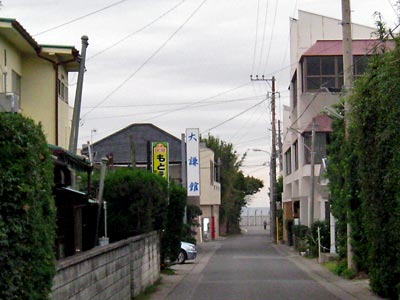

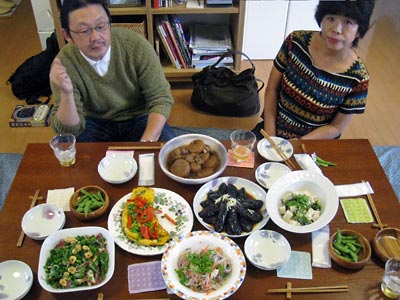
We also meet privately on numerous occasions.
Here, we were invited by a viola player to her new flat to consume her huge collection of hard liquor "shochu". We were all suprised by the cooking skill of our contrabassist (left - half of the dishes on the table were made by him.).
As for the conductor, we haven't had a regular conductor for quite long time, as we had certain troubles with aregular conductor. It has also its merit to choose a conductor for each concert. As there are so many amateur orchestras in Japan, many conductors can have engagements and earn a certain income, though they are not engaged by professional orchestras.
Torakyo collect no entrance fee for its concerts. Therefore we have to finance our activities totally by our members' subscription. It is a sort of dilemma whether to allow guests to our concerts free of charge. We think that we are just amateurs and don't want to take money for our hobby. But, there is also a consideration that we can secure guests by selling advance tickets, because people don't want to lose money if they have paid for a ticket, even if the amount is small.
Since I joined the Orchestra in 1982, members have been increasing steadily. Now there are well more than 100 members and for example the first violin group has 16 member players. We have almost equal size of male and female members. Female players are, similar to other orchestras, dominant in violin parts.
There are also many married couples within the orchestra. Therefore, it is not unusual that couples come to our regular training camps together with their children. Many young mothers also come and play in the orchestra. The other day, a young mother was standing near the viola group and holding a baby in her arms. I was surprised when I discovered that she was not just watching us playing, but also plays horn herself. Many young mothers come back to Torakyo after they have given birth to babies, thanks to the support of their husbands or parents.
Thus, I have enjoyed the music life in Torakyo for decades. I want to continue to enjoy music and friendship as a member of Torakyo till the end of my life, as many senior members did in the past!